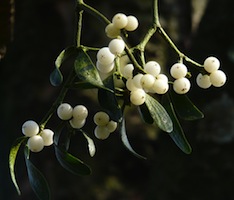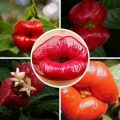- Mother’s Day Recipes You Can Make with Flowers - May 9, 2019
- Celebrating Flowers and Culture at the Shinnyo-en Lantern Floating Ceremony - March 29, 2018
- Give Easter Lilies This Spring - March 22, 2018
A symbol of the season, mistletoe is the iconic plant of Yuletide affection. Tied with a ribbon and hung above a door or threshold, tradition holds that lovers (or those who time their entrances wisely) smooch under the sprigs of mistletoe hung there. While this might make the plant a favorite for paramours, it is actually a slightly poisonous, parasitic plant that sucks the sap from trees in which it grows. How then did this leeching evergreen find its way down from the boughs of host trees an into the lore of Christmastime lovers?
Many researchers credit the tradition of kissing under the mistletoe to Druid mythology, specifically the Ritual of Oak and Mistletoe practiced among the Celtic people of what is now England and Ireland. It was thought at the time that mistletoe could be made into an elixir that could cure infertility. According to accounts written in the 1st century AD by the Roman historian, Pliny the Elder, mistletoe that was found growing high up in the branches of an oak tree were considered to be sacred. On the sixth night of the moon, priests clad in white would climb the tree to gather the mistletoe and make it into a concoction that was given to barren animals. Most species of the plant are toxic to humans in any sizable quantity, so offering this to cure infertility in humans seems questionable at best. In the language of flowers, however, it is still said to represent affection.
Like many other pagan traditions, this symbolic plant was slowly incorporated to more Christian traditions, so along with the Christmas tree and and Easter egg, the hanging of mistletoe this time of year found its way into modern day practices of early Europeans, particularly the British, French and Irish. Eventually, kissing under a sprig of this round-leafed evergreen followed Europeans over the pond, where it became a tradition in the New World as well.
There are several different species of mistletoe, including one (Phoradendron leucarpum) that is native to North America. The European mistletoe (Viscum album) is the species most commonly used for Yuletide smooching and can be found at many florists come December. It has small, rounded, light green leaves with small white or somewhat transparent berries. Gathered in a cluster and tied with a ribbon, these are sometimes sprayed with a preservative to help them last the season. While handling mistletoe poses no risk, keep them out of reach of pets and children, as the alkaloid they contain, tyramine, can make them quite sick. If this is a concern, try a sprig of holly hung it its place.
Whether you want an excuse to sneak in a kiss or simply want to carry on a tradition that dates back to the time of the Druids, hang a bit of mistletoe in your doorway this season.





